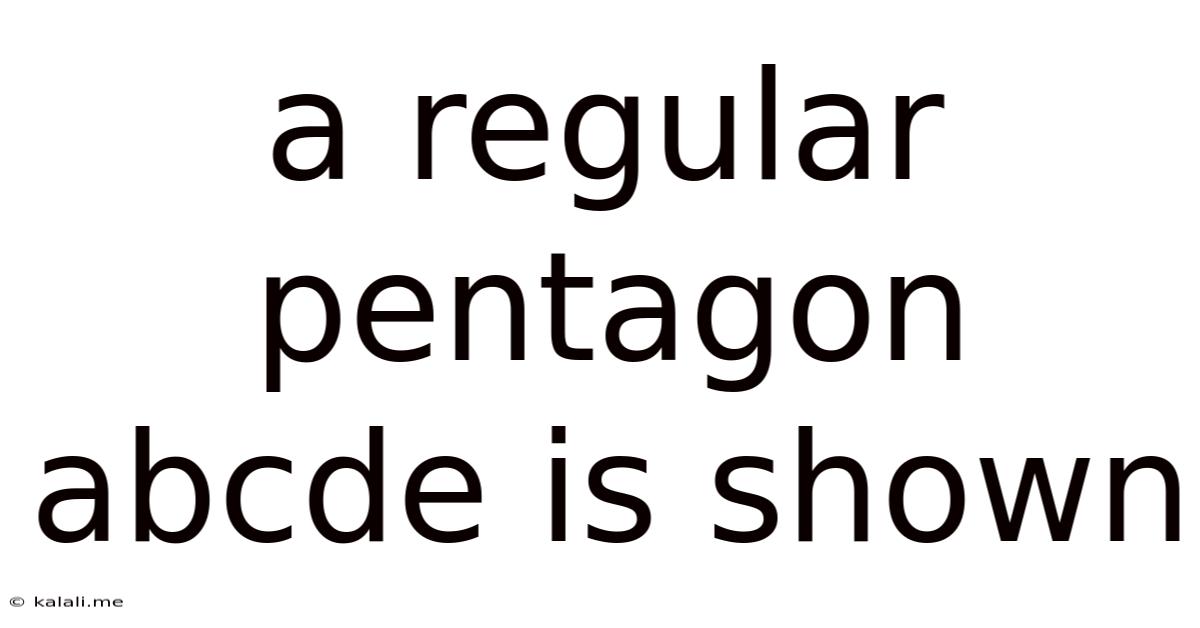A Regular Pentagon Abcde Is Shown
Kalali
Jun 11, 2025 · 3 min read

Table of Contents
Exploring the Regular Pentagon: ABCDE and its Properties
A regular pentagon, like ABCDE, is a fascinating geometric shape with unique properties that make it a rich subject for mathematical exploration. This article will delve into the characteristics of a regular pentagon, covering its angles, sides, diagonals, area calculation, and some interesting applications. Understanding these properties is crucial for various fields, from geometry and trigonometry to art, design, and even architecture.
What defines a Regular Pentagon?
A regular pentagon is a five-sided polygon where all five sides are of equal length, and all five interior angles are equal. This equidistance and equiangularity are key distinguishing features. Unlike irregular pentagons, which can have varying side lengths and angles, a regular pentagon possesses a high degree of symmetry. This symmetry makes it a visually appealing and mathematically predictable shape.
Key Properties of a Regular Pentagon:
-
Interior Angles: Each interior angle of a regular pentagon measures 108 degrees. This can be calculated using the formula for the sum of interior angles of a polygon: (n-2) * 180 degrees, where 'n' is the number of sides. For a pentagon (n=5), this sums to 540 degrees. Dividing by 5 gives the measure of each interior angle.
-
Exterior Angles: Each exterior angle of a regular pentagon measures 72 degrees (180 - 108 = 72). The sum of exterior angles of any polygon always equals 360 degrees.
-
Sides and Diagonals: All five sides are congruent (equal in length). The diagonals of a regular pentagon also possess interesting properties. They are all of equal length and intersect each other in a specific ratio related to the Golden Ratio (approximately 1.618). This connection to the Golden Ratio makes the regular pentagon appear aesthetically pleasing and is found in various art and design contexts.
Calculating the Area of a Regular Pentagon:
There are several ways to calculate the area of a regular pentagon. One common method involves dividing the pentagon into five congruent isosceles triangles, each with its apex at the center of the pentagon. The area of each triangle can then be calculated using the formula: (1/2) * base * height, where the base is the length of one side of the pentagon, and the height can be determined using trigonometry. The total area of the pentagon is then five times the area of one triangle. Alternatively, a formula specifically for the area of a regular pentagon using the side length ('s') can be used: Area = (5/4) * s² * cot(π/5).
Applications and Significance:
The regular pentagon's unique properties have led to its use in various applications:
-
Geometry and Trigonometry: It serves as a fundamental shape in geometric studies, offering opportunities to explore concepts like symmetry, angles, and ratios.
-
Architecture and Design: The visually appealing symmetry of the pentagon is often incorporated into architectural designs, from building structures to decorative elements. Think of the Pentagon building in Washington D.C. as a prime example.
-
Nature: Pentagonal shapes can be found in nature, such as in some types of flowers and crystals.
-
Art and Design: The Golden Ratio connection makes it a popular shape in artistic creations, contributing to its perceived beauty and harmony.
In conclusion, the regular pentagon ABCDE, with its symmetrical properties and connection to the Golden Ratio, presents a rich area of study within mathematics and has found extensive applications in diverse fields. Its unique characteristics make it a compelling geometric shape worthy of further exploration and appreciation.
Latest Posts
Latest Posts
-
Do The Contestants On Naked And Afraid Get Paid
Jul 01, 2025
-
How Many Yards Are In 7 Feet
Jul 01, 2025
-
What Is Shortest Book In The Bible
Jul 01, 2025
-
How Many Cups Of Orzo In A Pound
Jul 01, 2025
-
How Long Does It Take To Drive 30 Miles
Jul 01, 2025
Related Post
Thank you for visiting our website which covers about A Regular Pentagon Abcde Is Shown . We hope the information provided has been useful to you. Feel free to contact us if you have any questions or need further assistance. See you next time and don't miss to bookmark.